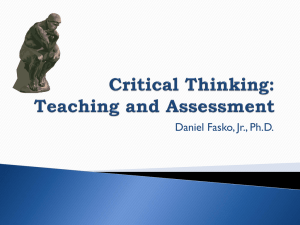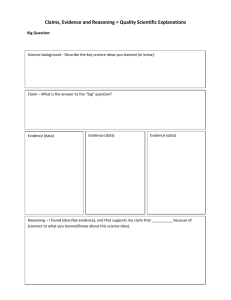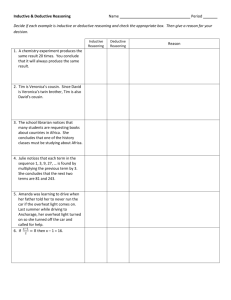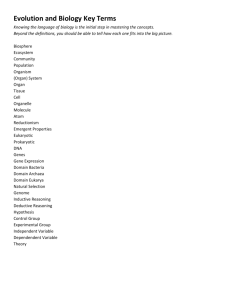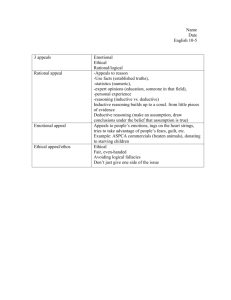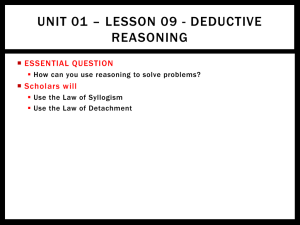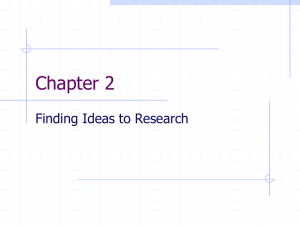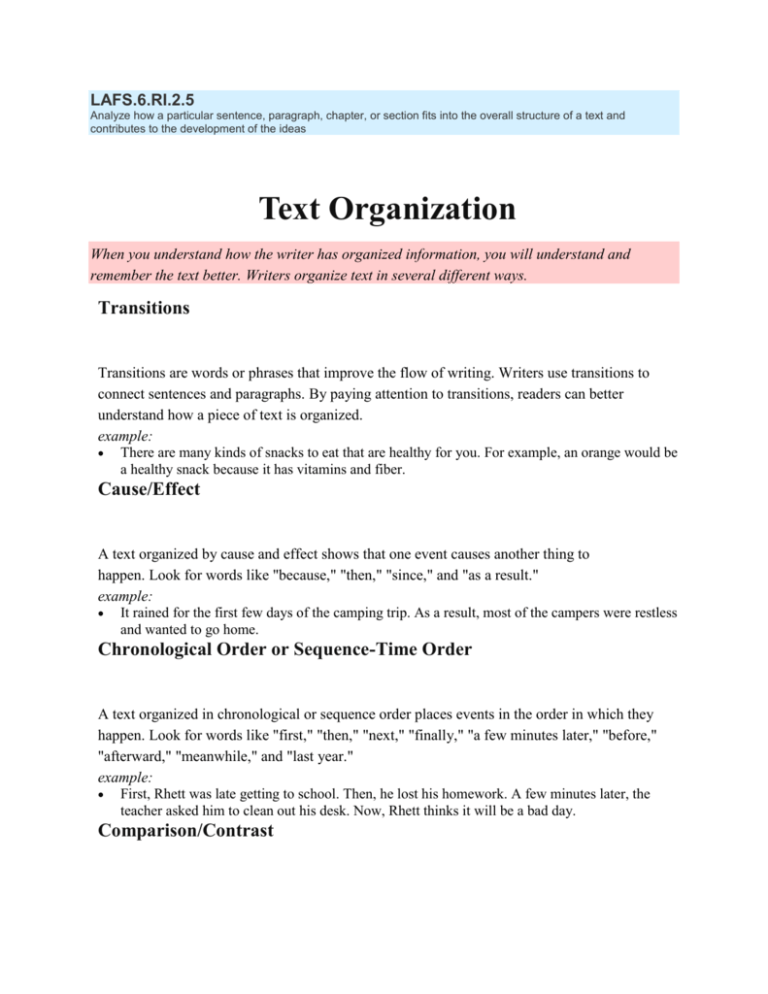
LAFS.6.RI.2.5
Analyze how a particular sentence, paragraph, chapter, or section fits into the overall structure of a text and
contributes to the development of the ideas
Text Organization
When you understand how the writer has organized information, you will understand and
remember the text better. Writers organize text in several different ways.
Transitions
Transitions are words or phrases that improve the flow of writing. Writers use transitions to
connect sentences and paragraphs. By paying attention to transitions, readers can better
understand how a piece of text is organized.
example:
There are many kinds of snacks to eat that are healthy for you. For example, an orange would be
a healthy snack because it has vitamins and fiber.
Cause/Effect
A text organized by cause and effect shows that one event causes another thing to
happen. Look for words like "because," "then," "since," and "as a result."
example:
It rained for the first few days of the camping trip. As a result, most of the campers were restless
and wanted to go home.
Chronological Order or Sequence-Time Order
A text organized in chronological or sequence order places events in the order in which they
happen. Look for words like "first," "then," "next," "finally," "a few minutes later," "before,"
"afterward," "meanwhile," and "last year."
example:
First, Rhett was late getting to school. Then, he lost his homework. A few minutes later, the
teacher asked him to clean out his desk. Now, Rhett thinks it will be a bad day.
Comparison/Contrast
A text organized by comparison and contrast shows how ideas or things are alike or
different. Look for words like "best," "more," "better," "less," "worse," "easier," and "than."
example:
The best time to visit the Rocky Mountains is early fall. The weather is cooler in the fall than in
the summer. You will see fewer people and more animals. The fall colors are more beautiful.
Logical Order
The text organized by logic reaches a logical conclusion from known details.Logical order
also can be ordering paragraphs into a larger whole with similar details grouped together.
example:
The door was cracked open and the kitchen was speckled with muddy paw prints, so we knew
that Patches, the neighbors' Dalmatian, had been in our house.
Inductive Reasoning
A text organized by inductive reasoning moves from the specific to the general.It is based on
experiences and observations. Using induction, the prediction is based on what is known or
observable. In this sense, it is a conclusion based on probability.
example:
Yesterday, we had to turn in an English assignment. Today, we also had to turn in another
assignment. Tomorrow, I assume we'll have another assignment.
Deductive Reasoning
A text organized by deductive reasoning begins with the general and ends with the specific. It
is based on laws, rules, or other accepted principles. Using deductive reasoning, the old or
accepted information is applied to a new context to form a conclusion. If the accepted
information, the premises, is correct, the conclusion is also correct. In this sense, the
conclusion leaves no room for probability.
example:
At the beginning of year, Ms. Hall gave us a list of our assignments. The list says that I have an
assignment due on April 30th. Therefore, I will have to turn in my assignment on April 30th.
Classification
A text organized by classification groups things that are similar. This structure can be very
helpful when writing research reports.
example:
You are writing a paper about the food pyramid. One paragraph is devoted to the benefits of
fruits and vegetables. One paragraph is devoted to the benefits of breads and carbohydrates, etc.
Spatial Order
A text organized by spatial order presents items according to their location.Look for words
like "over," "under," "beside," "next to," "behind," "left," "right," "above," "top," "bottom" etc.
example:
With my head and body resting on the wall, I stood in the garage surveying all the junk. I knew
Mom wanted me to move things so that her car would park easily in there. Next to me stood a
row of shelves that housed motor oil, garden tools, car wax, tools, and various odds and
ends. To my left, two bicycles rested gently against the wall. In the middle of the garage were
two rows of boxes stacked six feet high. To my right, the lawn mower, weed eater, leaf blower,
and a golf bag took up the spot where Mom wanted to park her car. I knew finding a space for
everything was going to be a challenge.
Order of Importance
A text organized by the order of importance progresses from the least to most important idea
or from the most to least important idea. Look for words like "first of all," "most important,"
"least important," etc.
example:
According to Abraham Maslow, the most important things that a person needs are food, sleep,
and good health. Without food, sleep, or good health, a person will find it difficult to focus on
anything else. The next most important needs are shelter and safety. A sense of belonging and
then self-esteem come next in importance. The least important need is achieving maximum
individual potential. Comment on Lesson
Copyright © 2014 Edmentum - All rights reserved.

